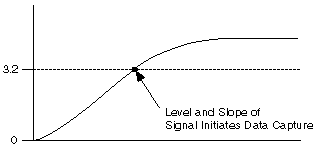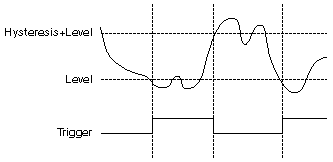Analog Edge Triggering
For analog edge triggering, you configure the measurement device to look for a certain signal level and slope (either rising or falling). After the device identifies the trigger condition, the device performs the specified action associated with the trigger, such as starting the measurement or marking which sample was acquired when the trigger occurred. You connect analog trigger signals to any analog input channel or terminal capable of accepting analog signals. Refer to the device-specific analog triggering considerations for your device for additional information.
In the following figure, the trigger is set to capture data for a rising edge signal when the signal reaches 3.2.

Hysteresis
Hysteresis adds a window above or below the trigger level and often is used to reduce false triggering due to noise or jitter in the signal. When using hysteresis with a rising slope, the trigger asserts when the signal starts below level (or threshold level) minus hysteresis and then crosses above level. The trigger deasserts when the signal crosses below level minus hysteresis.
For example, if you add a hysteresis of 1 to the previous example, which used a level of 3.2, the signal must start at or drop below 2.2 for triggering to occur. The trigger then asserts as the signal rises above 3.2 and deasserts when it falls below 2.2.

When using hysteresis with a falling slope, the trigger asserts when the signal starts above level (or threshold level) plus hysteresis and then crosses below level. The trigger deasserts when the signal crosses above level plus hysteresis. If you instead trigger on a falling edge at 3.2 with a hysteresis of 1, the signal must start at or rise above 4.2 for triggering to occur. The trigger will then assert as the signal falls below 3.2 and deassert when it rises above 4.2.

See Also